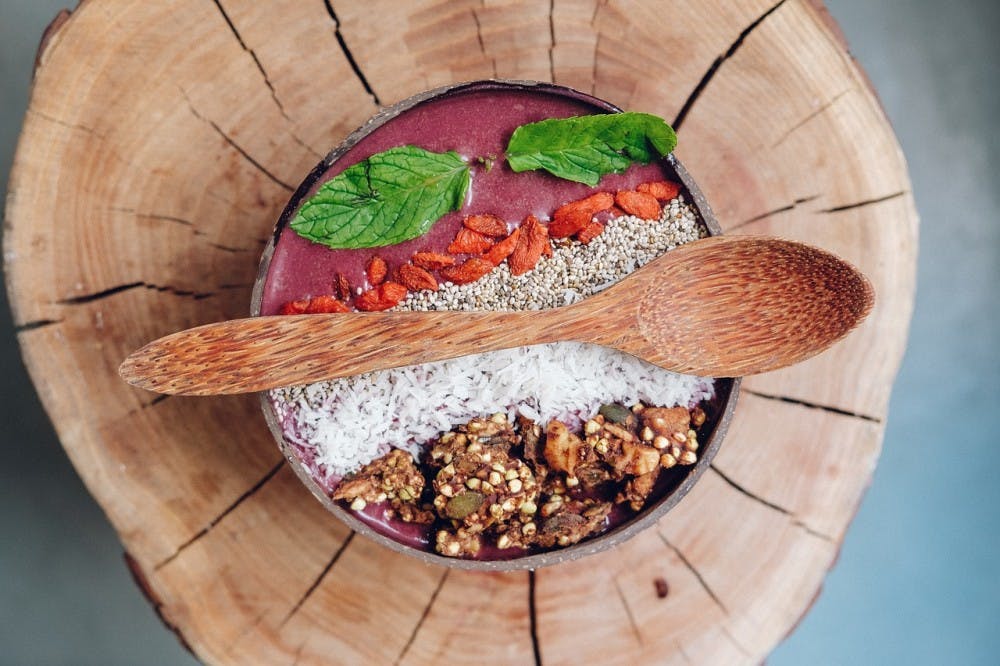Today I put on thigh-high boots and a slinky, dark blue sweater before I left my room. Calling it my “career-driven woman” outfit, based mostly on what I had seen in “The Devil Wears Prada,” I hoped it would inspire me to write this article before my deadline.
I arrived at Frutta Bowls on Nassau Street, a sleek modern café serving açaí bowls, the latest “millennial trend” — a term non-millennials tend to dish out for strange things a few young people are doing that most young people usually don’t know about. The açaí bowl is, however, a legitimate millennial trend, though over time it has become a popular meal across generations.
The basis for the açaí bowl’s popularity stems from its simultaneously delicious, healthy, and “aesthetic” qualities. Healthiness, in the case of trends like the açaí bowl, has become a type of aesthetic, tied to a feeling of self-satisfaction rather than guilt in preparing and consuming the meal. Typically eaten for breakfast, the açaí bowl consists of a smoothie base that uses the açaí berry, a “superfood,” topped with a plethora of ingredients, always placed with the utmost care in appealing patterns: chia seeds, goji berries, almond slices, sliced banana, peanut or almond butter. My proclaimed expertise on açaí bowls comes from watching one too many YouTube “Morning Routine” videos in which pretty girls who look perfectly disheveled film their breakfasts in high definition.
In the midst of enjoying my açaí bowl, it began to dawn upon me that I engage in many behaviors solely to achieve a particular “aesthetic,” often for no other audience than myself.
Upon opening Google Docs, I chose to type this article in Times New Roman instead of Arial before pulling my sweater sleeves over my wrists and getting to work. Last week I enjoyed the sensation of drinking coffee from a to-go cup while walking up campus, not because I relished the artificial taste of French vanilla, but because of the satisfaction I felt as I lifted the fashionable beverage to my lips. When I was younger, I used to call this satisfaction “feeling whole” without knowing how else to describe it. It would come over me suddenly — like when I put a certain outfit on a doll or wrote in a diary.
Perhaps my fixation with this feeling has been exacerbated by the nefarious influence of social media — another typical criticism of millennials. Such a desire to achieve certain aesthetics has produced phenomena like the açaí bowl, just as it has contributed to the popularity of social media sites like Instagram, which exist as platforms for people to photograph and share their açaí bowls, alongside other meals, outfits, pretty views, friends, or significant others. Naturally, the cynic in me starts questioning if this one person actually liked going to the club last night or if that other person actually read “Infinite Jest” on the beach. If we do everything for a certain aesthetic, rather than what lies beneath it, we may feel “whole” temporarily, but our relationships and experiences begin to feel empty.
At the same time, appreciating beauty, from a bowl of blended fruit to the Big Dipper on a walk back to my dorm at night, has allowed me to escape from the constant pressures of a success-oriented culture. It has taught me that there is more to life than charging toward achievement after achievement, that I should take time to smell the flowers, or order the açaí bowl. As we approach Christmas, I look forward to family and love and closeness, but also to the aesthetic of lights in the dark and bell sounds and an aroma of pine needles. There is something deeply moving — even holy — in it.









